American Journal of Plant Sciences
Vol.4 No.5(2013), Article ID:32160,11 pages DOI:10.4236/ajps.2013.45137
Potentials of Two Nigerian Spices—Piper nigrum and wang#s:TopTitleMonodora myristica as Sources for Cheapwang#e:TopTitle wang#s:TopTitleNatural Antioxidantswang#e:TopTitle
Department of Genetics and Biotechnology, University of Calabar, Calabar, Nigeria.
Email: *gen_uyoh @yahoo.com
Copyright © 2013 Edak A. Uyoh et al. This is an open access article distributed under the Creative Commons Attribution License, which permits unrestricted use, distribution, and reproduction in any medium, provided the original work is properly cited.
Received March 8th, 2013; revised April 13th, 2013; accepted May 9th, 2013
Keywords: Antioxidant; Piper nigrum; Monodora myristica; Spices; Free Radicals
ABSTRACT
Two commonly consumed spices in Nigeria—Piper nigrum (leaf and seed) and Monodora myristica (seed) were evaluated for natural antioxidant potentials in complementary in vitro assay systems. Extracts of the tested plant parts contained low amounts of antioxidant compounds: 4.00 - 6.65 µg GAE/mg and 2.50 - 10.38 µg RE/mg for phenols and flavonoids respectively. The extracts scavenged DPPH and hydroxyl radicals in the range of 4.32% - 37.37% (inferior to ascorbic acid and gallic acid used as standards) and 6.43% - 17.10% respectively. In the reducing power and phosphomolybdenum assays, the extracts showed ability to reduce Fe (III) and Mo (VI) ions to their lower valence states of Fe (II) and Mo (V) respectively, although these activities were inferior to those of the standards used. Comparatively, Monodora myristica seed extract was superior to Piper nigrum leaf and seed extracts in antioxidant potential, but all the extracts generally showed dose-dependent antioxidant activities. Evidently, the studied spice plants are not without some natural antioxidant capacity and would contribute appreciably in combating free radical damages when consumed.
1. Introduction
Plants are a valuable source of medicine and have helped in the maintenance of human health since time immemorial [1]. They constitute an important source of active natural products which differ widely in terms of structures, biological properties and mechanisms of action [2]. Over the past decades, the natural antioxidants of both nutritive and medicinal plants have been of significant interest to the pharmaceutical and food industries due to their roles in combating myriads of oxidative damages incurred by living cells and food products from free radicals’ activities [3,4]. Free radicals engage in electron pairing with important biological macromolecules in their quest for stable configuration. Consequently, they cause damage to DNA, lipids, proteins, and co-factors of enzymes resulting in a number of pathological disturbances including cancer, atherosclerosis, cardiovascular diseases, ageing and inflammatory diseases [5,6].
Among other plants, spices hold good promise as potential harmless sources for obtaining natural antioxidants [7]. The abundant locally consumed spice plants in Nigeria may therefore be potential rich reservoirs of antioxidants to be harnessed if studied and established [8]. Piper nigrum L. (family Piperaceae) and Monodora myristica L. (family Anonaceae) are common spices that find wide usage in Nigerian cuisines. Commonly called West African pepper, Piper nigrum’s leaves and seeds are equally effective as spices. In Nigeria, the plant is locally known as “Odusa” by the Efiks/Ibibios and “Uziza” by the Ibo speaking tribes. The seed contains piperine which gives it a spicy heat and is also reported to dramatically increase the absorption of selenium, vitamin B, betacarotene, curcumin and other nutrients. [9]. The anticarcinogenic effects of the extracts of this plant have been reported [10]. Monodora myristica, commonly called African nutmeg is cultivated mainly in the southern parts of Nigeria. The seeds are economically and medicinally important and the kernel obtained from the seed is a popular condiment used as a spicing agent in both African and Continental cuisines in Nigeria [11]. Reports on phytochemical screening of the seeds of this plant revealed the presence of flavonoids, glycosides, cyanogenic glycosides, saponins, tannins, steroids, oxalates and phytates [12]. The seed is used locally in the treatment of cough, headache, fever, skin diseases, and when ground to powder; helps relieve constipation and control passive uterine haemorrhage in women immediately after child birth [13]. The antibacterial effect of the oily seed extracts of African nutmeg has been reported [14], and the alcoholic extracts of the seed showed the ability to reverse the toxigenic effects of aflatoxin [15].
The search for natural antioxidants is on and spices are promising. Piper nigrum and Monodora myristica are consumed widely in Nigeria and it is necessary to extend this search to them. This would not only further justify their continued consumption, but may possibly reveal them as good candidates for obtaining cheap and accessible natural antioxidants for exploitation in pharmaceuticals. Against this backdrop therefore, this study was aimed at examining in selected in vitro assay systems, the antioxidant activities of Piper nigrum and Monodora myristica extracts.
2. Materials and Methods
2.1. Collection and Extraction of Plant Material
Fresh leaves and mature seeds of Piper nigrum, and mature seeds of Monodora myristica were procured from Watt market in Calabar (4˚59'36''N, 8˚19'05''E), Cross River State, Nigeria and authenticated by the plant taxonomist in Botany Department, University of Calabar. The plant materials were freed from debris, dried at room temperature, and milled separately using a blender (5 speed kitchen-aids 5KSB655CCS0).Seed coats of Monodora myristica were first removed and the inner kernels dried before milling (Figure 1). Ten (10) grams of each milled sample were extracted by soaking in 100ml of 90% methanol for 72h at room temperature with intermitent shaking. The samples were subsequently filtered using what man No. 1 filter paper at the end of the extraction period and concentrated under vacuum in a rotary evaporator at 45˚C for complete solvent removal. A sample stock solution of 3000 µg/ml was prepared for each extract by accurately weighing 0.3 g of the concentrated crude extract and dissolving in 100 ml of distilled water. Working solutions of each extract were prepared as desired by appropriate dilutions of the stock solutions.
2.2. Chemicals
DPPH (1,1-diphenyl-2-picryl hydrazyl) radical and Rutin were purchased from Sigma Aldrich Chemical Company, USA; Folin and Ciocalteau’s Phenol reagent and Trichloroacetic acid (TCA) from Qualikems Fine Chemical Pvt. Ltd., New Delhi, India; Gallic acid monohydrate from Kem Light Laboratories Pvt. Ltd., Mumbai, India. Solvents and other chemicals used for this study were of analytical grade, while water was glass distilled.
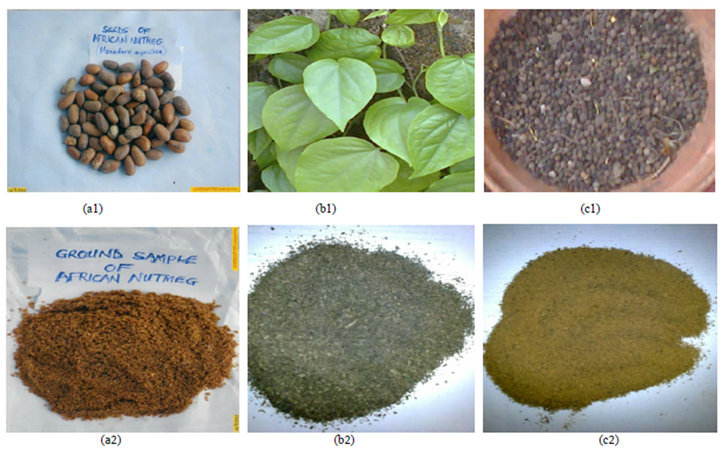
Figure 1. Plant materials used in this study. (a) Whole and milled samples; (b) Fresh and milled samples; (c) Whole and milled samples of M. myristica seeds of Piper nigrum leaves of Piper nigrum seeds, respectively.
2.3. Determination of Total Phenol Content (TPC)
The total phenol contents of the leaf and seed extracts of Piper nigrum and seed extracts of Monodora myristica were determined by the Folin-Ciocalteau method according to [16]. To 500µl of the different extract solutions were added 100 µl of Folin-Ciocalteau reagent plus 6 ml of distilled water and shaken for one (1) min. Thereafter, 2 ml of 15% sodium carbonate was added to the mixture and shaken once again for 30 sec. Finally, the solution was brought up to 10 ml by adding distilled water. After 1.5 h incubation at room temperature, the absorbance at 750 nm was evaluated using a spectrophotometer (LABTECH UV/VIS Spectrophotometer, India). Gallic acid monohydrate, a standard phenol, in the range of 0 - 240 µg/ml was used to prepare a standard reference curve. The total phenol contents (TPC) of the extracts were expressed as Gallic Acid Equivalents (GAE) from the linear regression curve of Gallic acid.
2.4. Determination of Total Flavonoid Content (TFC)
The total flavonoid contents of the leaf and seed extracts of Piper nigrum and seed extracts of Monodora myristica were determined using the aluminium chloride colorimetric method according to [17]. The different extract solutions (1 ml containing 100 µg /ml) were diluted with 4 ml of distilled water in a 10 ml volumetric flask. Thereafter, 0.3 ml of 5% sodium nitrite solution was added to each volumetric flask; 5 min later, 10% aluminium chloride (0.3 ml) was added; 1 min later, 2 ml of 1.0 M sodium hydroxide was added and finally, 2.4 ml of distilled water was then added to the reaction flask and mixed well. Absorbance of the reaction mixture was read at 510 nm. Rutin, a standard flavonoid, in the range of 0 - 135 µg/ml was used to prepare the standard reference curve. Total flavonoid contents (TFC) of the extracts were expressed as Rutin Equivalents (RE) from the linear regression curve of rutin.
2.5. DPPH (1,1-Diphenyl-2-picrylhydrazyl) Radical Scavenging Assay
Antioxidant activity of the leaf and seed extracts of Piper nigrum and seed extracts of Monodora myristica were measured in this assay as ability to scavenge stable DPPH radicals according to the method of [18]. Four (4) different concentrations (30, 60, 90 and 120 µg/ml) of the test extracts were prepared in methanol. To 2.5 ml solution of each extract concentration was added 1 ml of 0.3 mM of freshly prepared DPPH solution in methanol and allowed to react in the dark at room temperature for 30 min. Absorbance of the resulting solution was measured at 518 nm. Methanol (1 ml) added to 2.5 ml of each extract concentration was used as blank, while 1 ml of 0.3 mM DPPH solution added to 2.5 ml of methanol served as a negative control. Ascorbic acid and gallic acid, prepared in the same concentrations as the test extracts, were used as reference standards (positive controls) for comparison.
Percentage DPPH scavenging activities of the extracts and reference standards were determined using the formula: % scavenging activity = 100 − [(As − Ab)/Ac × 100], where As = Absorbance of sample (extract or reference standard), Ab = Absorbance of blank and Ac = Absorbance of negative control [5].
2.6. Total Antioxidant Capacity (TAC) Assay
The total antioxidant capacity (TAC) of the leaf and seed extracts of Piper nigrum and seed extract of Monodora myristica were determined by the phosphomolybdate method according to [19]. An aliquot (300 µl) of different concentrations (30, 60, 90 and 120 µg/ml) of the test extracts were mixed with 3 ml of the reagent solution (0.6 M sulphuric acid, 28 mM sodium phosphate, 4 mM ammonium molybdate) taken in test tubes. The tubes were capped with aluminium foil and incubated in a boiling water bath at 95˚C for 90 min. The reaction mixture was allowed to cool to room temperature and the absorbance of the solution was measured at 695 nm against a blank containing 3 ml of reagent solution and the appropriate volume of the dissolving solvent. The blank was incubated under the same conditions as the test samples. Ascorbic acid and rutin were used as standard reference compounds to compare the activities of the extracts. Results were expressed in absorbance values at 695 nm.
2.7. Hydroxyl (OH) Radical Scavenging Assay
The hydroxyl radical scavenging activity of the leaf and seed extracts of Piper nigrum and seed extract of Monodora myristica were determined by the Fenton reaction using the ortho-phenanthroline method according to the modified procedure of [20]. 4 ml of sodium phosphate buffer (0.2 M, pH 7.4), 1.5 ml of 5 mM orthophenanthroline (1, 10 phenanthroline) in ethanol and I ml of 7.5 mM Iron (II) sulphate were mixed simultaneously. Then, 1 ml of different concentrations (1.5 - 3.0 mg/ml) of each extract, 1.5 ml of distilled water and 1 ml of 1% hydrogen peroxide were added to the mixture solution in sequence. After incubating at 37˚C for 60 min, the change of reaction mixture in absorbance, caused by the colour change of Fe-orthophenanthroline was measured at 510 nm. A damage control (control in the hydroxyl radical generation system) was constituted with distilled water in place of extracts and references. A blank was constituted with distilled water, without sample and hydrogen peroxide. Ascorbic acid and rutin were used as standard antioxidant compounds for comparison of the extracts’ activities. Hydroxyl radicals scavenging activity was evaluated as: Scavenging Activity (%) = [(As – Ao/Ab – Ao)] × 100, Where As = Absorbance of reaction mixture with sample or standard, Ao = Absorbance of damage control and Ab = Absorbance of blank.
2.8. Reducing Power Assay
Antioxidant activity of the leaf and seed extracts of Piper nigrum and seed extract of Monodora myristica were determined in this assay as their Fe3+ reducing ability according to the method of [21]. Different concentrations (30, 60, 90 and 120 µg/ml) of each extract were prepared and 1 ml of each concentration was mixed with 2.5 ml of phosphate buffer (0.2 M, pH 6.8) and 2.5 ml of potassium ferricyanide. The mixture was incubated in a water bath at 50˚C for 20 min. To this mixture, 2.5 ml of 10% trichloroacetic acid was added before centrifuging (Rotofix 32, Germany) at 3000 rpm for 10 min. The upper layer of the solution (2.5 ml) was mixed with 2.5 ml of distilled water and 0.5 ml of 0.1% ferric chloride was added. Absorbance of the Pert Prussian blue solution formed was measured at 700 nm using a spectrophotometer. Ascorbic acid and rutin were used as reference standards for comparison and were prepared in same concentrations as the extracts. Results were expressed as absorbance values at 700 nm (Increasing absorbance value indicated increasing reducing power).
2.9. Statistical Analysis
The experiment was laid out in a Completely Randomized Design and data were analyzed using a one-way analysis of variance (ANOVA). The arrangement for analyses of all the assays was a 5 × 4 factorial except for total phenol and flavonoid contents of the extracts. All measurements were replicated five times and results were expressed as means ± standard error. Significant means were separated using the Least Significant Difference
(LSD) analysis.
3. RESULTS
3.1. Total Phenol Content (TPC)
The total phenol contents of the tested plant extracts were estimated quantitatively from a linear regression curve (y = 0.4982 + 0.0101x, r2 = 0.948) of Gallic acid, a standard phenol, and expressed in micrograms Gallic acid equivalents per milligram of sample (µg GAE/mg sample). Piper nigrum leaf extract had a significantly higher (p < 0.05) mean total phenol content (6.68 µg GAE/mg) than Piper nigrum seed extract (4.12 µg GAE/mg) and Monodora myristica seed extract (4.00 µg GAE/mg) which in themselves do not differ significantly (Table 1).
3.2. Total Flavonoid Content (TFC)
The total flavonoid contents of the extracts were estimated quantitatively from a linear regression curve (y = 0.0937 + 0.0008x, r2 = 0.954) of Rutin, a standard flavonoid, and presented in microgram Rutin equivalents per milligram of sample (µg RE/mg sample). The seed extract of Monodora myristica had a mean total flavonoid content of 10.38 µg RE/mg which was significantly higher (p < 0.01) than that of Piper nigrum leaf extract (2.50 µg RE/mg), while no flavonoid was detected in the Piper nigrum seed extract (Table 1).
3.3. DPPH Radical Scavenging Assay
This assay investigated the ability of the studied extracts to act as donors of hydrogen atoms or electrons in transformation of DPPH radical into its reduced form. Table 2 shows the comparative DPPH scavenging activities of the extract relative to the reference standards. Monodora myristica seed extract had the highest mean scavenging power (37.37%) of the studied extracts and was significantly higher (p < 0.001) than the mean scavenging powers of Piper nigrum leaf (19.69%) and seed (4.32%) extracts. The scavenging activities of the tested extracts

Table 1. Total phenol and flavonoid contents (TPC and TFC) of the leaf and seed extracts of Piper nigrum and Monodora myristica seed extract.
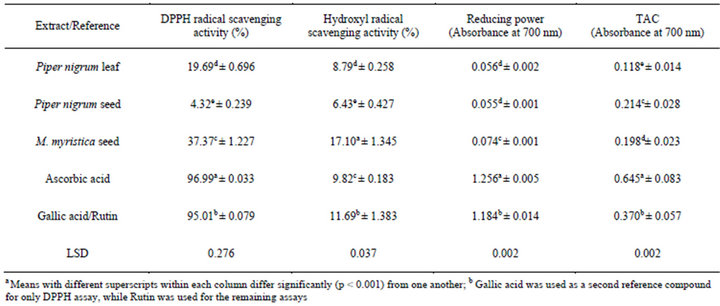
Table 2. DPPH radical scavenging activity, Hydroxyl radical scavenging activity, Reducing power and Total antioxidant capacity (TAC) of leaf and seed extracts of Piper nigrum and Monodora myristica seed extract compared with reference compounds.
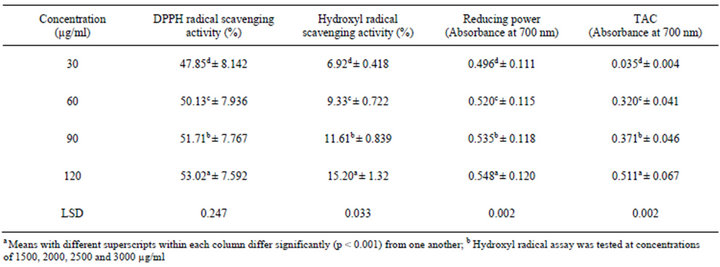
Table 3. Pooled DPPH radical scavenging activity, Hydroxyl radical scavenging activity, Reducing power and Total antioxidant capacity (TAC) of the different tested concentrations of Piper nigrum and Monodora myristica extracts and reference compounds.
were however not comparable to those of ascorbic acid (96.99%) and gallic acid (95.01%) used as reference standards. DPPH scavenging activities of the tested samples were observed to be dose-dependent, with higher concentrations of each sample showing higher scavenging activities (Table 3, Figure 2).
3.4. Total Antioxidant Capacity (TAC)
Total antioxidant capacity was evaluated on the basis of the ability of the constituent antioxidant compounds in the tested extracts to reduce Mo (VI) ions to Mo (V). Results were reported as mean absorbance values at 695 nm (Table 2). of the studied extracts, Piper nigrum seed extract had the highest mean absorbance value (0.214) which was significantly higher (p < 0.001) than that of Monodora myristica seed extract (0.198), while Piper nigrum leaf extract had the least mean value of 0.118. Ascorbic acid and rutin used as reference compounds were superior to all the extracts in this assay (0.645 and 0.370 respectively). Generally, total antioxidant capacities of the test samples were dependent on concentration. Higher concentrations of each sample showed significantly higher activity as evident from Table 3 and Figure 3.
3.5. Hydroxyl Radical Scavenging Assay
The hydroxyl radical scavenging abilities of the tested plant extracts, compared with ascorbic acid and rutin are presented in Table 2. Significant differences (p < 0.001) were observed in the mean scavenging activities of the samples which can be summarized in this order: Monodora myristica seed extract (17.01%) > Rutin (11.69%) > Ascorbic acid (9.82%) > Piper nigrum leaf extract (8.79%)
(8.79%) > Piper nigrum seed extract (6.43). Increasing concentrations of all the samples resulted in increased scavenging activities (Table 3), indicating that the antioxidant activity in this assay is dose-dependent (Figure 4).
3.6. Reducing Power
The reducing abilities of tested plant extracts, compared with ascorbic acid and rutin are presented as mean absorbance values at 700 nm in Table 2. Higher absorbance values indicate higher reducing power. Among the extracts, Monodora myristica seed extract had a mean absorbance value of 0.074 which was significantly higher (p < 0.001) than those of Piper nigrum leaf extract (0.056) and Piper nigrum seed extract (0.055). The mean absorbance values of the Piper extracts were statistically same; however, reducing powers of all the extracts were significantly lower than those of ascorbic acid (1.256) and rutin (1.184). Reducing powers of all the samples increased with higher concentrations (Table 3; Figure 5).
4. Discussion
The utility of plants as natural antioxidants is due mainly to the wide range of active natural products inherent in them, prominent among which are the phenols and flavonoids. Many studies have found a good correlation between the relative abundance of these two phytochem-
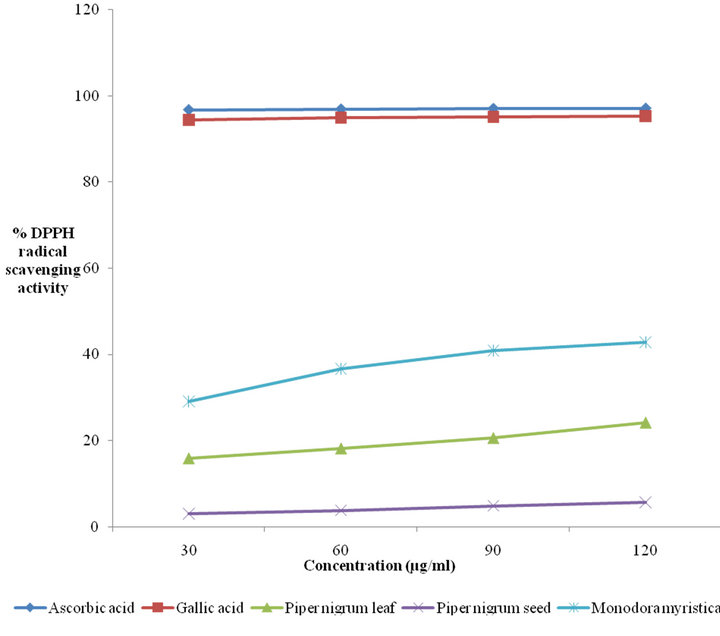
Figure 2. DPPH radical scavenging activities of Piper nigrum leaf and seed extracts, Monodora myristica seed extract and reference compounds at different concentrations.
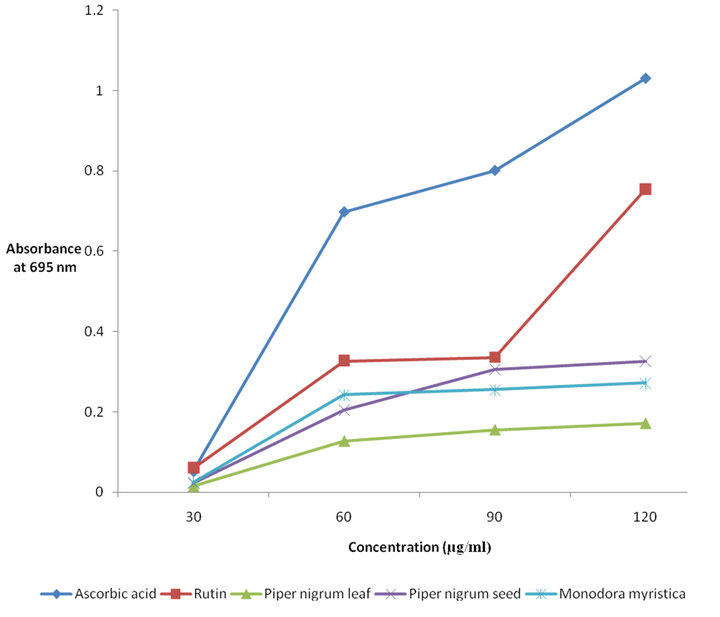
Figure 3. Total antioxidant capacity of Piper nigrum leaf and seed extracts, Monodora myristica seed extract, and reference compounds at different concentrations.
icals to antioxidant activities. In this study, the tested plant extracts contained low amounts of phenols and flavonoids, although the values were higher than the range reported for some edible spices [22]. Phenol compounds possess a broad spectrum of biological activities including antioxidant and radical scavenging properties [23], and their antioxidant potential is believed to be conferred on them by the presence of a hydroxyl functional group (-OH), which is bonded directly to an aromatic hydrocarbon (phenyl) ring. This makes them readily donate electrons to free radicals and stabilize them before they destroy living cells. Flavonoids also are potent watersoluble super antioxidants that function in scavenging free radicals, inhibition of peroxidation and chelating transition metals [24]. The presence of phenols and flavonoids in the studied plant extracts, although in low amounts, is still an indication that they possess the necessary bioactive compounds needed to confer antioxidant activities on them.
Radical scavenging is one of the mechanisms of antioxidant activities [25], and the DPPH assay provides a convenient, rapid and easy method to evaluate antioxidants and radical scavengers [26]. It is based on the ability of 1,1-diphenyl-2-picryl-hydrazyl (DPPH), a stable free radical, to decolorize in the presence of antioxidants. The DPPH radical contains an odd electron, which is responsible for the absorbance at 515nm and also for the visible deep purple colour. When DPPH accepts an electron donated by an antioxidant compound, the DPPH is decolorized, and this effect can be quantitatively measured from the changes in absorbance [27]. The studied spice extracts showed some potency in scavenging DPPH free radicals with Monodora myristica showing superior activities to the Piper nigrum extracts. Although the extracts were generally not comparable to the standards used for comparison, their ability to scavenge some of the DPPH free radicals is a confirmation of their capacity as radical scavengers which could find application as natural antioxidants.
The hydroxyl radical scavenging activities of the studied spice extracts were generally low at the concentrations tested but quite remarkably, Monodora myristicaseed extract scavenged more hydroxyl radicals than known antioxidant compounds (ascorbic acid and rutin) used for comparison. The values were also higher than those reported for other spices in Nigeria, noteably Ocimum spp [8]. Piper nigrum extracts showed significantly reduced hydroxyl radical scavenging; however, the leaf extract showed more potency than the seed extract. This activity by the spice extracts may suggest that they may also have the capacity to prevent important bio membranes and bio molecules from being attacked by free radicals especially the more damaging hydroxyl radicals [28].
A potent antioxidant often acts as a potent reductant thus; in vitro reduction of metal ions is an important mechanism used to evaluate antioxidant action [29]. The tested spice extracts generally displayed some potency in reducing Mo (VI) to Mo (V) complex in the phosphomolydenum assay. Although this activity was not comparable with the activities of the reference compounds, it however confirms the presence of reductants in them and proves that they could serve as electron donors, terminating the free radical chain reactions [30].
In the reducing power assay, the presence of antioxidants in the samples would result in the reduction of Fe3+ to its lower valence state, Fe2+, by donating an electron. Amount of Fe2+ complex can then be monitored by measuring the formation of Perl’s Prussian blue at 700 nm. Increasing absorbance at 700 nm indicates an increase in reductive ability [31]. The reducing properties are generally associated with the presence of reductones which have been shown to exert antioxidant action by breaking the free radical chain through electron donation [32]. The absorbance values obtained with the spice extracts studied, though not comparable to reference compounds, confirm that Fe3+-Fe2+ transformation occurred in the presence of the extracts, thereby confirming their anti-
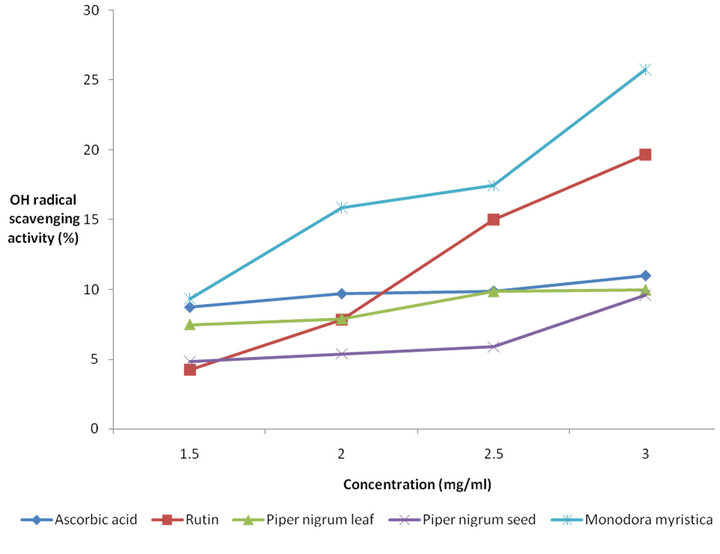
Figure 4. Hydroxyl radical scavenging activities of Piper nigrum leaf and seed extracts, Monodora myristica seed extract and reference compounds at different concentrations.
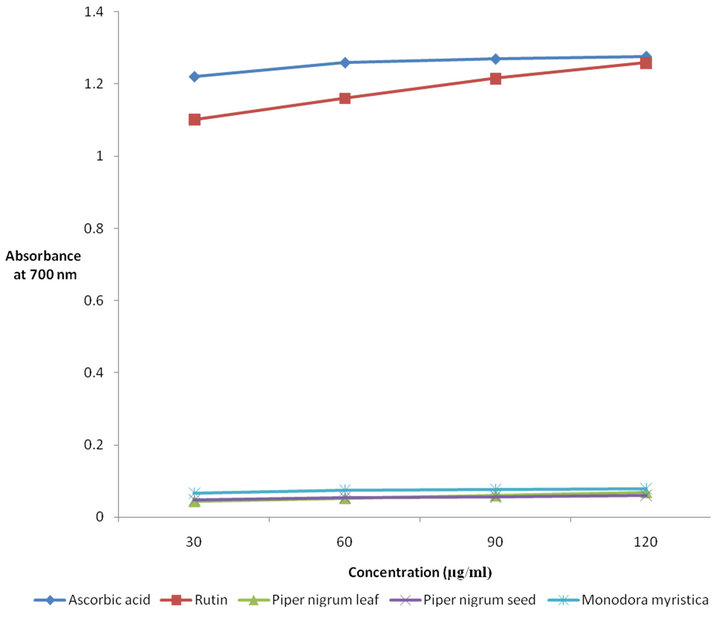
Figure 5. Reducing powers of Piper nigrum leaf and seed extracts, Monodora myristica seed extract and reference compounds at different concentrations.
oxidant potentials.
5. Conclusion
The results of the present study provide some scientific evidence that edible parts of Piper nigrum and Monodora myristica consumed widely in Nigeria possess appreciable natural antioxidant potentials, with Monodora myristica seed showing superiority to Piper nigrum seed and leaf. On the basis of these results therefore, the evaluated spices can be presented as cheap and easily accessible sources of natural antioxidants when consumed and which may show prospect for pharmaceutical industries if further research establishes their utility in this respect.
6. Acknowledgements
The authors are grateful to STEP-B (Nigeria) for the provision of some of the equipment used in this research.
REFERENCES
- M. M. Cowan, “Plant Products as Microbial Agents,” Clinical Microbiology Reviews, Vol. 12, 1999, pp. 564-582.
- B. Nickavar, M. Kamalinejad and H. Izadpanah, “In Vitro Free Radical Scavenging Activity of Five Salvia Species,” Pakistan Journal of Pharmaceutical Science, Vol. 20, No. 4, 2007, pp. 291-294.
- Y. Abiy, “Antimicrobial Flavonoids from the Stem Bark of Erythrina burtii,” Fitoterapia, Vol. 96, 2005, pp. 496- 499.
- P. Tangkankul, P. Auttaviboonkul, B. Niyomwit, N. Lowvitoon, P. Charoenthamawat and G. Trakoontivakorn, “Antioxidant Capacity, Total Phenolics Content and Nutritional Composition of Asian Foods after Thermal Processing,” International Food Research Journal, Vol. 16, 2009, pp. 571-580.
- L. L. Mensor, F. S. Menezes, G. G. Leitao, A. S. Reis, T. C. dos Santos, C. S. Coube and S. G. Leitao, “Screening of Brazilian Plant Extracts for Antioxidant Activity by the Use of DPPH Free Radical Method,” Phytotherapy Research, Vol. 15, No. 2, 2001, pp. 127-130. doi:10.1002/ptr.687
- U. Ozgen, A. Mavi, Z. Terzi, A. Yildrim, M. Coskun and P. J. Houghton, “Antioxidant Properties of Some Medicinal Laminaceae Species,” Pharmaceutical Biology, Vol. 44, No. 2, 2006, pp. 107-112. doi:10.1080/13880200600592061
- D. E. Okwu, “Phytochemicals and Vitamin Content of Indigenous Spices of South Eastern Nigeria,” Journal of Sustainable Agriculture and Environment, Vol. 6, 2004, pp. 30-34.
- E. A. Uyoh, P. N. Chukwurah, I. A. David and A. C. Bassey, “Evaluation of Antioxidant Capacity of Two Ocimum species Consumed Locally as Spices in Nigeria as a Justification for Increased Domestication,” American Journal of Plant Sciences, Vol. 4, 2013, pp. 222-230. doi:10.4236/ajps.2013.42029
- J. A. Duke, “CRC Handbook of Alternative Cash Crops,” CRC Press, Boca Raton, 2009, p. 395
- N. Nalini, V. Manju and V. P. Menon, “Effect of Spices on Lipid Metabolism in 1,2-Dimethylhydrazine Induced Rat Colon Carcinogenesis,” Journal of Medicinal Food, Vol. 9, No. 2, 2006, pp. 237-245. doi:10.1089/jmf.2006.9.237
- J. C. Okafor, “Development of Forestry Crops for Food Supplies in Nigeria,” Forest Ecological Manual, Vol. 1, 1987, pp. 235-247. doi:10.1016/0378-1127(76)90028-1
- C. R. Ekeanyanwu, G. I. Ogu and P. U. Nwachukwu, “Biochemical Characteristics of African Nutmeg, Monodora myristica,” Agricultural Journal, Vol. 5, No. 5, 2010, pp. 303-308. doi:10.3923/aj.2010.303.308
- L. T. Kigigha and J. C. Enebi, “Effect of Peper-Soup Cooking on the Antibacterial Activity of Monodora myristica,” Continental Journal of Food Science and Technology, Vol. 6, No. 1, 2012, pp. 8-11. doi:10.5707/cjfst.2012.6.1.8.11
- U. E. Udoh, C. O. Ezeugwu and I. U. Ajali, “Antimicrobial Activity of Monodora myristica Seed Oil,” Journal of Pharmacology and Allied Science, Vol. 2, No. 2, 2004, pp. 233-236.
- F. Oluwafemi and V. O. Taiwo, “Reversal of Toxigenic Effects of Aflatoxin B1 on Cockerels by Alcoholic Extract of African Nutmeg, Monodora myristica,” Journal of the Science of Food and Agriculture, Vol. 84, No. 4, 2009, pp. 333-340. doi:10.1002/jsfa.1626
- J. M. Duarte-Almeida, A. V. Novoa, A. F. Linares, F. M. Lajolo and M. I. Genovese, “Antioxidant Activity of Phenolic Compounds from Sugar Cane (Saccharum officinarum L.) Juice,” Plant Foods for Human Nutrition, Vol. 61, No. 4, 2006, pp. 187-192. doi:10.1007/s11130-006-0032-6
- V. Dewanto, X. Wu, K. K. Adom and R. H. Liu, “Thermal Processing Enhances the Nutritional Value of Tomatoes by Increasing Total Antioxidant Activity,” Journal of Agricultural and Food Chemistry, Vol. 50, No. 10, 2002, pp. 3010-3014. doi:10.1021/jf0115589
- L. L. Mensor, F. S. Menezes, G. G. Leitao, A. S. Reis, T. C. dos Santos, C. S. Coube and S. G. Leitao, “Screening of Brazilian Plant Extracts for Antioxidant Activity by the Use of DPPH Free Radical Method,” Phytotherapy Research, Vol. 15, No. 2, 2001, pp. 127-130. doi:10.1002/ptr.687
- G. K. Jayaprakasha, B. S. Jena, P. S. Negi and K. K. Sakariah, “Evaluation of Antioxidant Activities and Mutagenicity of Turmeric Oil: A Byproduct from Curcumin Production,” Zeitschrift für Naturforschung, Vol. 57, 2002, pp. 828-835.
- K. R. Nagulendran, S. Velavan, R. Mahesh and V. Hazeena Begum, “In Vitro Antioxidant Activity and Total Polyphenolic Content of Cyperusrotundus rhizomes,” European Journal of Chemistry, Vol. 4, 2007, pp. 440-449.
- A. Sheetal, S. B. Millind and H. Srinivasa, “Antioxidant Activity of Stem Bark of Tespesia populnea,” Journal of Natural Remedies, Vol. 7, No. 1, 2007, pp. 135-141.
- M. A. Hala, “Comparative Antioxidant Activity Study of Some Edible Plants Used Spices in Egypt,” Journal of American Science, Vol. 7, No. 1, 2011, pp. 1118-1122.
- E. A. Melo, J. M. Filho and N. B. Guerra, “Characterization of Antioxidant Compounds in Aqueous Coriander Extracts (Coriander sativum L.),” Lebensmittel-Wissenschaft and Technologie, Vol. 38, 2005, pp. 15-19.
- B. Nickavar, M. Kamalinejad and H. Izadpanah, “In Vitro Free Radical Scavenging Activity of Five Salvia Species,” Pakistan Journal of Pharmaceutical Science, Vol. 20, No. 4, 2007, pp. 291-294.
- N. C. Cook and S. Samman, “Flavonoids-Chemistry, Metabolism, Cardioprotective Effects and Dietary Sources,” Journal of Nutritional Biochemistry, Vol. 7, 1996, pp. 66-76. doi:10.1016/0955-2863(95)00168-9
- V. Roginsky and E. A. Lissi, “Review of Methods to Determine Chain-Breaking Antioxidant Activity in Food,” Food Chemistry, Vol. 92, 2005, pp. 235-254. doi:10.1016/j.foodchem.2004.08.004
- M. R. Saha, S. M. R. Hasan, R. Akter M. M. Hossain, M. S., Alam, M. A. Alam and M. E. H. Mazunder, “In Vitro Free Radical Scavenging Activity of Methanol Extract of the Leaves of Mimusops elengi Linn,” Bangladesh Journal of Veterinary Medicine, Vol. 6, No. 2, 2008, pp. 197- 202.
- E. O. Farombi, T. O. Akuru and M. C. Alabi, “Mechanisms of the Hepatoprotective Action of Kolaviron: Studies on Hepatic Enzymes, Microsomal Lipids and Lipid Peroxidation in Carbon Tetrachloride-Treated Rats,” Pharmacology Research, Vol. 42, No. 1, 2000, pp. 75-80. doi:10.1006/phrs.1999.0648
- E. Niki, “Assessment of Antioxidant Capacity in Vitro and in Vivo,” Free Radical Biology and Medicine, Vol. 49, 2010, pp. 503-515. doi:10.1016/j.freeradbiomed.2010.04.016
- M. A. Ebrahimzadeh, S. F. Nabavi, S. M. Nabavi, B. Eslami and H. Asgarira, “In Vitro Antioxidant and Free Radical Scavenging Activity of Leonurus cardiaca Subsp. Persicus, Grammosciadium platycarpum and Onosmadem awendicum,” African Journal of Biotechnology, Vol. 9, No. 51, 2010, pp. 8865-8871.
- K. N. V. Rao, R. Aradhana, D. Banjii, R. S. N. Chaitanya and A. Anil Kumar, “In Vitro Anti-Oxidant and Free Radical Scavenging Activity of Various Extracts of Tectona grandis Linn Leaves,” Journal of Pharmacy Research, Vol. 4, No. 2, 2011, pp. 440-442.
- P. D. Duh, Y. Y. Tu and G. C. Yen, “Antioxidant Activity of the Aqueous Extract of Harnjyur (Chrysanthemum morifolium Ramat),” Lebensmittel-Wissenschaft and Technologie, Vol. 32, 1999, pp. 269-277.
NOTES
*Corresponding author.

